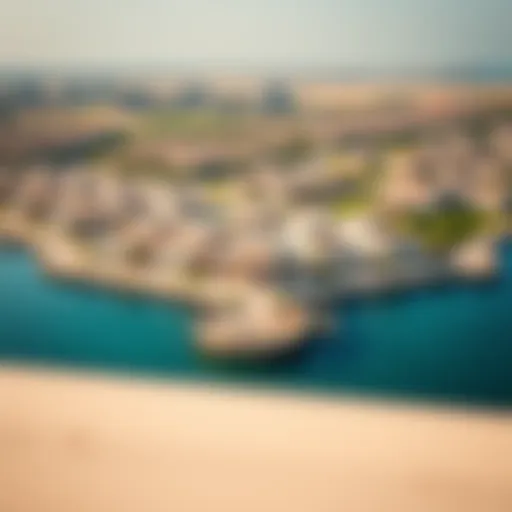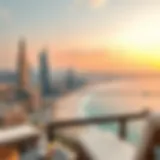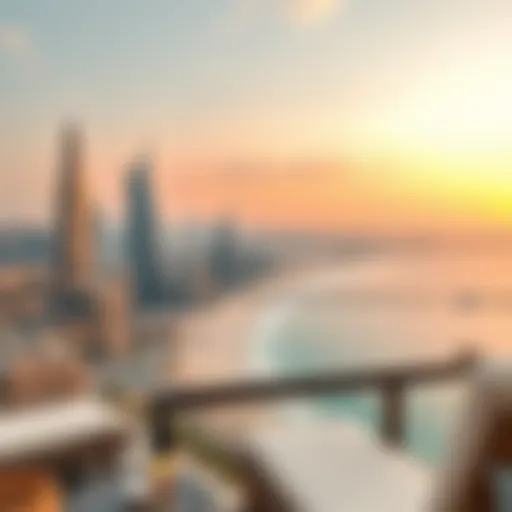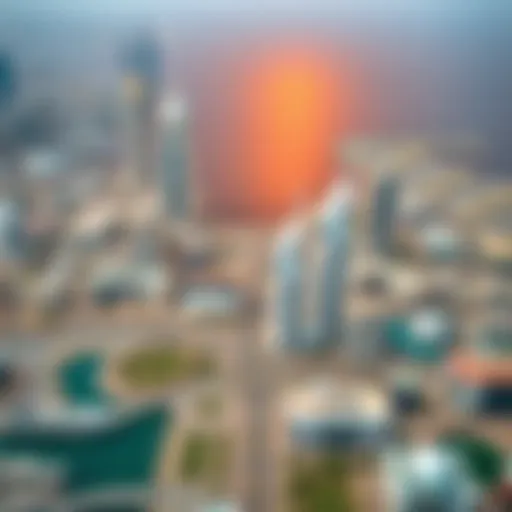Explore Dubai's Stunning Architectural Mosque
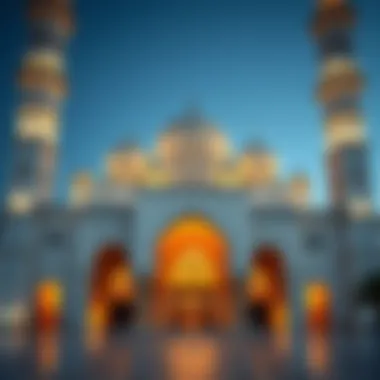
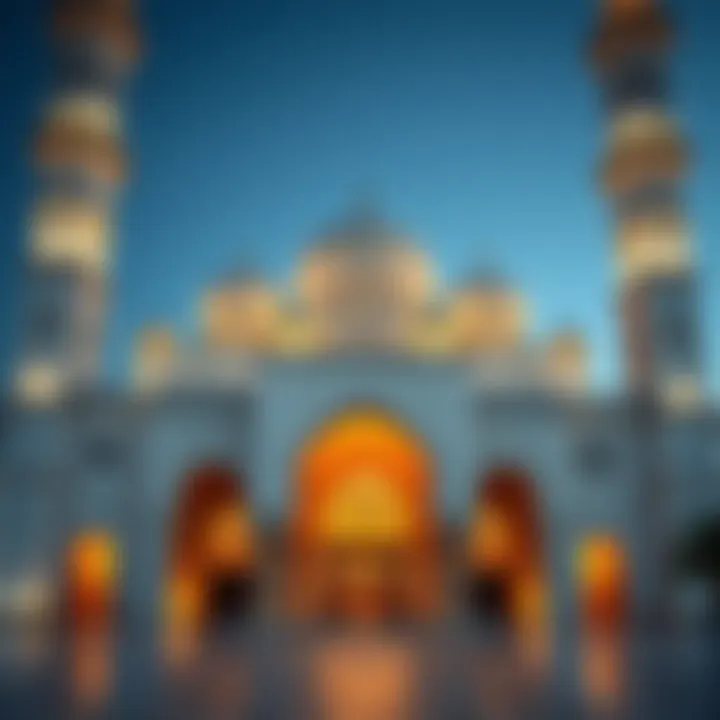
Intro
Dubai, a city known for its towering skyscrapers and luxurious lifestyle, is also home to some of the world's most breathtaking architecture. Among these structures lies a mosque that captures the essence of Islamic design and cultural importance, making it a must-see landmark. This article takes a closer look at the mosque's architectural brilliance, its historical background, and its significant role in the community. With its elaborate designs and spiritual ambiance, the mosque stands as a testament to Dubai's commitment to preserving its rich heritage.
As we journey through the intricate details of this stunning mosque, we will touch upon the materials that create its majestic facade, the history that has shaped it, and how it serves as a community hub. In doing so, we will illustrate not just its beauty, but its role as a vital connecting point for locals and visitors alike.
More than just a religious place, this mosque symbolizes unity and inclusion. It attracts tourists, offers spiritual solace, and fosters a deeper understanding of the Islamic faith. The ensuing sections will provide a thorough analysis, elevating the conversation beyond mere admiration into a realm of appreciation for its cultural and societal impacts.
Foreword to the Mosque
The role of the mosque in any community, particularly in a city as dynamic as Dubai, stretches far beyond its physical boundaries. This article aims to explore the significance of one specific mosque—the most beautiful one in Dubai. It is essential to understand not just its architectural marvel but also its deep-rooted importance in Dubai's social, cultural, and religious fabric. The mosque serves as a centerpiece, showcasing how modernity can beautifully coexist with tradition.
Overview of Dubai’s Religious Landscape
Dubai’s religious landscape is a fascinating tapestry woven from diverse cultures and beliefs. While the city is predominantly Muslim, its skyline is punctuated with churches, temples, and other places of worship as well. This blend is intentional; Dubai aims to be a city that respects and accommodates various faiths and communities.
Mosques in Dubai hold a special significance, acting not merely as places of worship but as community hubs where various educational and charitable activities take place. Visitors may note how seamlessly these facilities are integrated into daily life, evident in the bustling environment surrounding them.
- Examples of notable mosques, aside from the one in focus, include:
- Sheikh Zayed Grand Mosque: Although located in Abu Dhabi, it influences many architectural structures in Dubai.
- Al Farooq Omar Bin Al Khattab Mosque: Known for its unique blend of Turkish and Ottoman architecture.
- Jumeirah Mosque: One of the few mosques open to non-Muslim visitors, symbolizing religious tolerance.
Each mosque contributes its own character to the city’s landscape, making it to a vibrant hub for spiritual interactions and cultural exchange.
Significance of Mosques in Islamic Culture
In Islamic culture, mosques are not just structures; they symbolize a connection to the divine and a community’s identity. They serve as places for prayer, education, and gathering, thus reinforcing social ties. The idea of community is pivotal; mosques often provide support systems for the elderly, educational programs for youth, and charitable outreach initiatives.
Moreover, mosques represent a sense of peace and belonging. The call to prayer punctuates the day’s rhythm, reminding the community of their spiritual commitments. The architectural design of mosques often includes elements that inspire awe—large domes, tall minarets, and intricate tiling—each contributing to an environment conducive to contemplation.
- Key roles mosques fulfill in Islamic culture include:
- Spiritual Renewal: Encouraging individual and community prayer offerings.
- Education and Learning: Hosting classes on religious studies and languages.
- Cultural Exchange: Fostering dialogue among various communities.
"Mosques are not merely places of worship; they are living institutions that mold communities and echo their histories."
By understanding this cultural context, we gain insight into how the most beautiful mosque in Dubai plays a vital part in nurturing community ties and fostering a deeper appreciation for Islamic tradition, all while remaining a key architectural landmark.
The Architectural Design
Design plays a pivotal role in the identity of the mosque, establishing it not only as a place of worship but also as a centerpiece of aesthetic and cultural significance. The architectural elements reflect the richness of Islamic art and construction methods that have evolved over centuries. A careful exploration of design ensures a deeper appreciation for the integration of spirituality and beauty, making it essential to understand the mosque’s architectural aspects.
Influences and Inspirations
The design of the mosque draws inspiration from a myriad of sources, effectively weaving together various stylistic strands common in Islamic architecture. This is not merely a replication of tradition but rather a thoughtful adaptation of influences. The signature elements showcase a blend of regional aesthetics — such as ornate domes reminiscent of the Taj Mahal, combined with the graceful arches typically found in Andalusian mosques.
Visiting this architectural marvel, one can't help but notice the nods to local culture as well. Traditional motifs and geometric patterns are incorporated into the façade, serving as a reminder of the history that defines this vibrant city. Furthermore, the integration of modern elements alongside classic designs highlights a forward-thinking approach that respects the past while looking toward the future.
Materials and Techniques Used
The choice of materials is equally critical in achieving both durability and visual impact. The mosque is constructed primarily from high-quality white marble sourced from Italy, giving it a striking, pristine appearance that gleams under the desert sun. This choice is no accident; marble is not only aesthetically pleasing but also effective in reflecting heat, which is vital in an arid climate like Dubai’s.
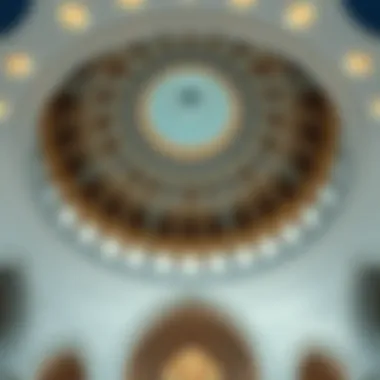
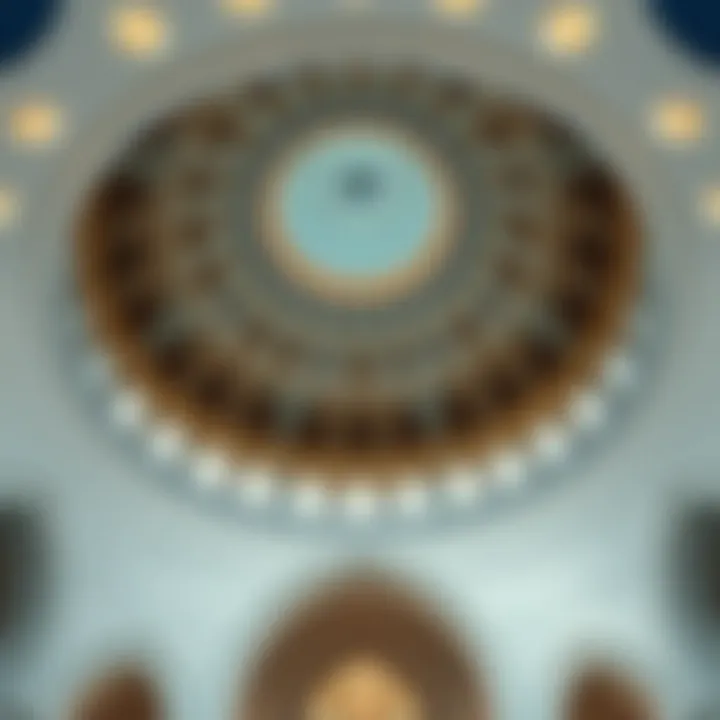
Additionally, intricate mosaics adorn many surfaces, crafted using thousands of tiny tile pieces laid deftly by skilled artisans. This meticulous craftsmanship exemplifies the intricate artistry inherent in Islamic design. Techniques such as mashrabiya, wooden lattice screens, are utilized not just for decoration, but also to create mesmerizing patterns of light and shadow within the prayer halls.
Landscaping and Surroundings
Surrounding the mosque, the landscaping plays a crucial role in enhancing the overall experience for visitors. Thoughtfully designed gardens filled with native plants provide a tranquil contrast to the striking architecture. These green spaces serve as a serene environment for contemplation and meditation, inviting community interaction.
Water features such as fountains accentuate the calming atmosphere. They are not only visually appealing but also add to the cooling effects in the heated atmosphere, grounding the space in a sensory experience that is soothing and refreshing. The layout of paths and seating areas encourages movement and reflection, providing ample opportunities for both tourists and locals to connect with the space and with each other.
The architectural design of the mosque is not merely about visual appeal; it embodies a harmonious blend of spirituality, culture, and community.
In summary, the architectural design of the mosque goes beyond being just a structure. Each carefully chosen element—from the inspirations behind its creation to the materials used and the surrounding landscapes—tells a story of its own. This holistic approach not only enriches the aesthetic but also reinforces the mosque’s role as a cultural and spiritual hub in Dubai.
Historical Context
Understanding the historical context of the mosque not only adds depth to its architectural splendor, but it also highlights its role within modern Dubai. This section delves into the origins of the mosque and the significant events that have shaped its existence, offering a clearer view of its cultural and spiritual symbolism in society.
Origins and Development of the Mosque
The origins of this stunning mosque can be traced back to a period of remarkable expansion in Dubai. During the late 20th century, as the city began to transform from a modest coastal town into a global hub, the need for modern places of worship became increasingly clear. Driven by a vision to reflect the city's burgeoning identity, the mosque was conceived not just as a place for spiritual gatherings but also as a beacon of architectural brilliance.
Construction began in [insert specific year], embodying a unique blend of traditional Islamic elements and contemporary artistry. The choice of location was no coincidence; placed at the heart of Dubai, the mosque serves as a spiritual anchor amidst the city's rapid development. With its towering minaret and intricate dome, it swiftly became a landmark, drawing both residents and tourists alike.
Later, influences from diverse architectural styles began to shape its structure, reflecting the melting pot of cultures that Dubai represents. The architects drew inspiration from historical mosques in the region—each element meticulously chosen to resonate with both legacy and modernism. This fusion exemplifies how the past can inform the future, lending the mosque its distinctive aesthetic.
Key Events in Its History
As with any monumental structure, the mosque's history is punctuated by key events that have defined its role within the community.
- Inauguration Ceremony: The official opening ceremony was held in [insert year], drawing a crowd of dignitaries and local citizens. This event marked not only the completion of construction but also the mosque's status as a vital part of Dubai's cultural landscape.
- Interfaith Dialogues: In [insert year], the mosque hosted a series of interfaith dialogue sessions aimed at promoting understanding among different religions. These events underscored the mosque's role as a space for community engagement—encouraging peace and cooperation in a rapidly changing world.
- Cultural Celebrations: Over the years, significant Islamic holidays, such as Eid al-Fitr and Ramadan, have been celebrated here with great fervor, attracting attendees from various backgrounds. These events have solidified the mosque's position as a unifying force in Dubai's diverse society.
- Architectural Recognition: In [insert year], the mosque received notable awards for its architecture, further establishing its significance as a standout example of Islamic design. This recognition brought global attention, making it a must-see destination for tourists and architecture enthusiasts alike.
Through these events, the mosque has solidified its identity as not just a place of worship but as a dynamic participant in the city's cultural narrative. As Dubai continues to evolve, the mosque remains a steadfast symbol of the beauty and complexity of its historical journey, reminding us all of the importance of heritage in shaping contemporary society.
“A mosque is more than just a building; it's a living testament to the values and traditions that bind us.”
Cultural Significance
The cultural significance of the mosque resonates deeply within the social fabric of Dubai. Beyond being a mere structure of worship, this mosque embodies the rich heritage of Islamic architectural brilliance and serves as a beacon for community interaction and spiritual growth. It plays a multifaceted role in the intertwining narratives of religion, art, and social development, fostering a sense of unity among diverse populations.
Role in Community Engagement
One might say that mosques are the beating heart of Muslim communities. This mosque, in particular, has become a pivotal gathering place for both locals and expatriates. It hosts a variety of events that reflect the spirit of community engagement, such as Quranic competitions, educational seminars, and cultural festivals. It's not just about religion; it’s about bringing people together.
The architecture of the mosque, with its inviting courtyards and serene spaces, encourages communal activities. Families often come to celebrate life events—from weddings to communal iftars during Ramadan. These activities help strengthen ties among community members, allowing them to connect on a deeper level.
The mosque also plays a key role in charity and social welfare initiatives, often acting as a hub for collecting donations to aid local causes. Such involvement provides a platform for residents to contribute to the welfare of others, creating an environment of giving and support.
Interfaith Dialogue Initiatives
In a city as cosmopolitan as Dubai, interfaith dialogue takes on an essential role in promoting mutual respect and understanding. This mosque actively encourages such exchanges, welcoming visitors from various faiths to partake in discussions and events aimed at fostering tolerance and peace.
Programs designed to facilitate open dialogue often occur, with talks led by knowledgeable figures. This approach demystifies misconceptions about Islam, providing attendees with genuine insights into the faith and its practices. Moreover, it reflects a commitment to coexistence, showcasing the mosque as more than a place of worship but also as an institution that advocates harmony across cultural divides.
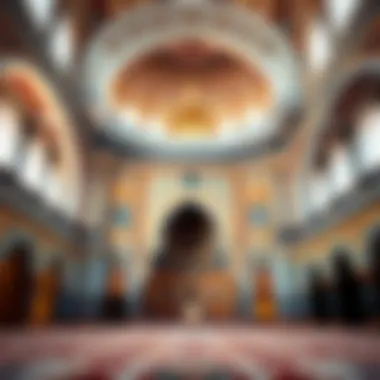
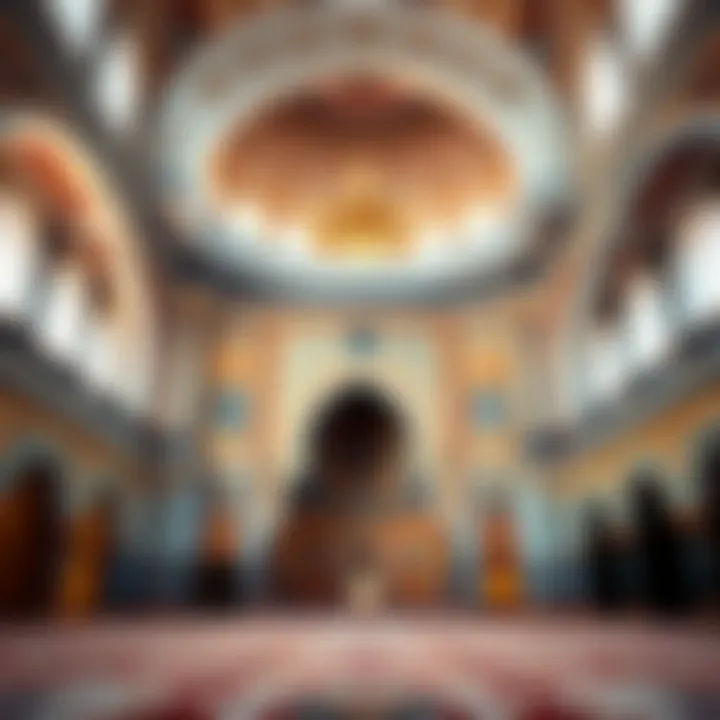
Reports indicate that these initiatives are instrumental not only in educating the public but also in reinforcing Dubai's identity as a global city—a melting pot of cultures and beliefs. Through these dialogues, the mosque significantly contributes to the broader societal understanding, enhancing Dubai’s appeal as a hub for cultural exchange.
"The mosque serves as a reminder that understanding and respect can bridge divides and foster a community where everyone feels valued."
In summary, the cultural significance of this mosque extends far beyond its stunning architecture. Its role in community engagement and interfaith dialogue initiatives illustrates the vital part it plays in nurturing a culture of inclusivity, compassion, and understanding within the vibrant landscape of Dubai.
Visitation and Access
Visitation and access to a mosque often mark the intersection of culture, spirituality, and community engagement. For the most beautiful mosque in Dubai, understanding how to visit can deepen the experience and provide travelers insight into the local faith and customs. The mosque stands as more than just an architectural wonder; it’s a place where the community converges and traditions thrive. A respectful visit can foster an appreciation for the resilience and beauty of Islamic architecture in a modern city.
Visitor Guidelines and Etiquette
When planning a visit, it’s crucial to observe proper guidelines and etiquette. Below are some key considerations:
- Dress Code: Visitors are expected to dress conservatively. For women, this often means wearing a long dress or skirt and covering their hair with a scarf. Men should wear long pants and avoid sleeveless shirts.
- Photography Rules: While the mosque is visually stunning, it is important to respect the sanctity of the space. Many mosques allow photography, but there are areas where it is prohibited. Always ask before snapping a photo to avoid any cultural faux pas.
- Behavior Expectations: Loud noises, casual language, and physical displays of affection should be avoided. It’s best to maintain a respectful demeanor as you explore the spaces within.
- Learning Opportunities: Take advantage of the guided tours offered. Guides often provide rich histories and context about the mosque that enhance one’s understanding.
Those wishing to enter are often welcomed warmly, as long as they approach the visit with respect and a readiness to learn. Visitors will find that many locals are eager to share their culture and customs.
Best Times to Visit
Timing is everything when it comes to experiencing the full essence of the mosque. Here are a few tips on when to plan your visit:
- Weekdays vs. Weekends: Weekdays are generally less crowded compared to weekends, particularly Friday. Local worshipers attend on Friday, making it a vibrant yet busy time at the mosque, especially during prayer hours.
- Avoiding Heat: Dubai's weather can be extreme; late afternoons or early evenings are ideal times, especially during the hotter months. The time just before sunset can also offer stunning views as the sun paints the mosque in golden hues.
- Special Events: Some holidays and religious events draw larger crowds. If attending during these times, expect more visitors and vibrant activities. Eid celebrations, for instance, are a sight to behold but can disrupt quiet contemplation.
In essence, selecting the right time can significantly enhance your experience and allow for a deeper connection with the spiritual and cultural atmosphere.
"A visit to the mosque is not just about seeing it; it’s about understanding and connecting with the story it tells—a narrative carved through architecture, faith, and community."
Tourism and Economic Impact
The mosque stands as a beacon in Dubai’s ever-expanding skyline, attracting both devout worshippers and curious tourists alike. Its significant role in Dubai's tourism landscape cannot be overstated, shaping how the city is perceived on a global scale. As the city continues to develop its status as a leading tourist destination, this mosque enhances its cultural fabric and economic vitality. This section will delve into two core elements: its attraction for tourists and its contribution to Dubai’s bustling economy.
Attraction for Tourists
When one visits Dubai, the grandeur of its mosques often leaves a lasting impression. The mosque, in particular, is a showstopper, combining stunning architecture with rich cultural heritage. Tourists gravitate towards its intricately designed domes, grand minarets, and beautifully landscaped gardens. The following aspects of its design draw in visitors:
- Visual Splendor: The captivating beauty of the mosque is not only about size; it also includes meticulous attention to detail, from the intricate mosaics to the delicate calligraphy that fans out across its walls.
- Cultural Experience: The mosque offers guided tours that provide a glimpse into the Islamic faith, allowing tourists to engage in cultural exchange and gain a deeper understanding of local traditions.
- Photography Opportunities: The stunning architecture presents abundant opportunities for photographers, whether amateurs or professionals, to capture its beauty against the Dubai skyline.
As a result, the mosque not only serves as a spiritual hub but also as a key player in Dubai’s tourist attractions, drawing thousands who seek to connect with its splendor.
Contribution to Dubai’s Economy
The mosque’s impact on Dubai’s economy is multifaceted, with benefits that ripple across various sectors. Local businesses thrive thanks to the influx of visitors, who often turn their trip to the mosque into a full day of exploration. Here’s a closer look at how the mosque contributes to economic growth:
- Job Creation: The tourism generated by the mosque has led to an increase in job opportunities in sectors such as hospitality, transportation, and retail. Every visitor potentially supports various local employees, from tour guides to shop owners.
- Boost to Local Businesses: Restaurants and shops nearby see higher foot traffic, as visitors often combine their trip to the mosque with local dining and shopping experiences. This increased patronage spurs growth in these small businesses.
- Cultural Funding: Additionally, the mosque plays a vital role in cultural funding, as ticket sales and donations may help support ongoing maintenance and preservation, ensuring both economic sustainability and cultural integrity.
"In essence, the mosque embodies not just spiritual enrichment but also serves as a significant economic engine, weaving itself into the very fabric of Dubai’s community and culture."
As Dubai continues to strengthen its position on the global stage, the mosque is poised to remain a central pillar, luring in visitors and contributing to the economic landscape of this dynamic city. Its balance of beauty and utility offers a template for how architectural wonders can effectively support modern economies.
Artistic Elements
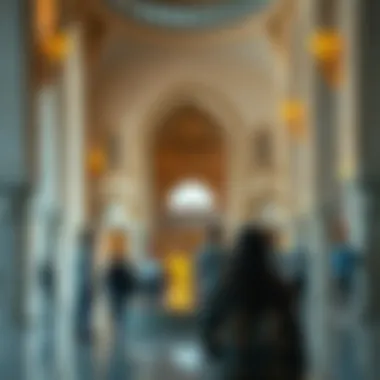
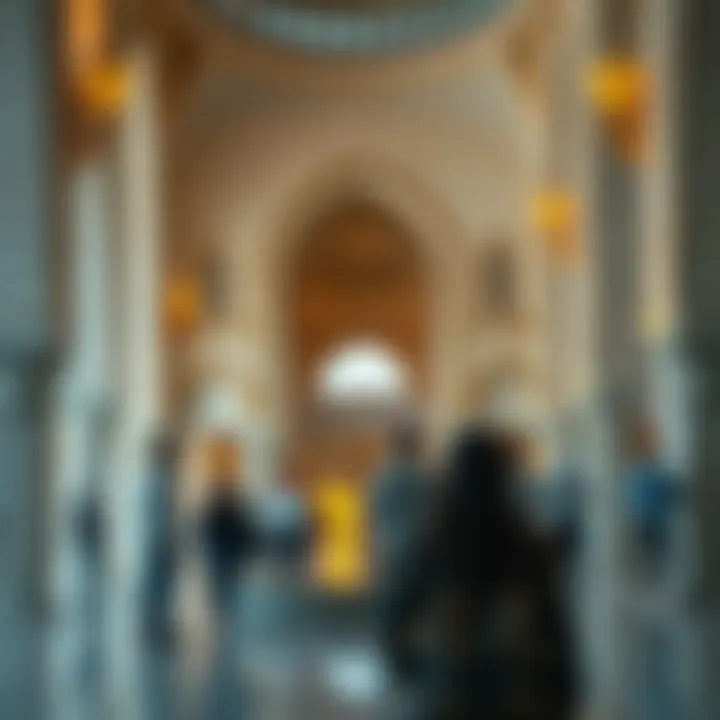
Artistic elements play a pivotal role in the allure and significance of the mosque in Dubai. These features not only enhance its aesthetic appeal but also reflect the intricate cultural heritage and the spiritual ethos of Islam. The careful integration of artistic components ensures that this mosque is not just a place of worship, but also a canvas that tells a story and evokes emotions among its visitors. From the calligraphy that adorns its walls to the ambient lighting that shapes its atmosphere, every artistic detail contributes to creating a unique experience. This section will unravel these artistic elements, focusing on calligraphy and decorative arts, as well as the lighting and ambiance that collectively heighten the mosque's grandeur.
Calligraphy and Decorative Arts
Calligraphy and decorative arts are at the forefront of Islamic art, and the mosque in Dubai exemplifies this beautifully. Arabic calligraphy, with its flowing curves and intricate patterns, is more than just writing; it embodies the spiritual and intellectual pursuits of the Islamic community. Skilled artisans painstakingly inscribe verses from the Quran onto walls and ceilings, turning texts into mesmerizing art forms that engage and inspire.
The meticulous attention to detail in decorative motifs often draws inspiration from geometric patterns and nature. These patterns symbolize the infinite nature of Allah, leading the observer into a deep contemplation of faith. It’s not uncommon to see floral designs intertwined with geometric shapes, creating a visual dialogue that beckons the eye to explore every nook and cranny of the mosque.
As visitors step inside, they are greeted by a marriage of vibrant colors and harmonious designs which serve to elevate the spiritual atmosphere, inviting reflection and peace. The use of decorative arts underlines the fact that expression through art is deeply rooted in Islamic culture, where creativity serves as a means of connecting with the divine.
Lighting and Ambiance
The lighting within the mosque is thoughtfully designed, playing a crucial role in shaping the overall ambiance. This aspect is often overlooked, yet it profoundly affects the experience of worshippers and visitors alike. Natural light filters through intricately designed stained glass windows, casting patterns on the marble floors in a dance of colors that change throughout the day, highlighting the mosque’s architectural details.
Moreover, the artificial lighting is equally impressive, with fixtures that complement the architectural features, enhancing the sense of tranquility. Soft lighting illuminates the calligraphy and decorative arts without overpowering them, allowing for a serene environment conducive to prayer and contemplation. It’s as if the mosque breathes with the gentle changes in light, fostering a sacred space where one can connect with their faith.
A well-planned lighting design not only contributes to beauty but also to safety and functionality, guiding visitors through the various spaces within the mosque while ensuring that everything is visible and accessible.
"In the interplay of light and art, the true essence of the mosque emerges, a tapestry of faith woven into the fabric of community life."
The artistic elements—including calligraphy, decoration, and lighting—combine to create an environment that transcends aesthetics. They invite exploration and reflection, proving that this mosque holds a treasure trove of beauty and spirituality that resonates deeply with all who enter.
Environmental Considerations
As the world grapples with environmental issues, the role of architecture in promoting sustainability has never been more critical. The mosque in Dubai stands as a testament to the possibilities of merging beauty with eco-friendly practices. When one thinks about a mosque, the immediate associations often lean towards holy serenity, intricate designs, and community. However, it is equally important to recognize its environmental footprint.
Emphasizing sustainability within its architectural framework showcases not just aesthetic value but also a commitment toward nurturing the planet. This mosque, among others, serves as a beacon; it aims to inspire both residents and visitors to adopt greener lifestyles.
Sustainable Practices in Design
Incorporating sustainable practices has become a guiding principle in the mosque's design. Here are some critical elements that showcase this commitment:
- Use of Local Materials: Reclaiming local resources minimizes transportation emissions, enhancing the mosque's ecological footprint. The natural stone, produced within the region, provides a durable yet beautiful exterior, reducing the need for synthetic alternatives that may have a higher environmental cost.
- Energy Efficiency: With the rising cost and environmental toll of energy consumption, the mosque integrates advanced technologies for energy saving. For instance, solar panels strategically hidden along the roof's design harness sunlight, converting it to power without distracting from the building's beauty.
- Water Management Systems: A sophisticated rainwater harvesting system has been installed, which exemplifies foresight in resource management. This collected water not only nourishes the surrounding gardens but also contributes to the mosque's amenities, showcasing a seamless blend of function and form.
- Natural Ventilation Techniques: The architect employed natural airflow designs which allow for abundant cooling without excessive reliance on air conditioning. By strategically positioning windows and designing open spaces, the mosque captures breezes that create a refreshing environment, optimizing comfort in a desert climate.
Implementing these sustainable practices is not just a necessary step; it's part of a larger dialogue about our responsibility towards preserving the earth.
"The construction of contemporary architectural marvels should never come at the cost of the environment. Instead, we should forge a path that honors nature while celebrating human ingenuity."
In essence, the mosque is not just a place of worship; it embodies a holistic approach to architectural innovation, where every brick laid contributes positively to the ecosystem. The efforts seen here are not just for the clergy and congregants but stand as a model for future developments in urban settings. Understanding and implementing sustainability in religious structures in Dubai can inspire broader efforts across the Middle East and beyond, promoting a legacy of environmental mindfulness that is as beautiful as the designs themselves.
Epilogue
The significance of concluding this exploration of the mosque lies in crystallizing its enduring legacy and the multifaceted aspects that make it a cornerstone of both Dubai's skyline and cultural ethos. The intricate artistry, historical relevance, and community engagement woven into its fabric draw not only locals but attract an international audience who seek a deeper understanding of Islamic architecture and culture.
One cannot overlook how this mosque is a beacon of tranquility and reflection amidst the bustling life of Dubai. It serves as a reminder of the deep-rooted traditions and beliefs of the Islamic faith while also embodying modern architectural elegance. The use of local materials and sustainable building practices reflect a commitment to environmental stewardship, an increasingly pivotal consideration in today's world.
Additionally, the fostering of interfaith dialogue initiatives rooted within the mosque’s community outreach marks a hopeful perspective for future co-existence and understanding among different cultures. This mosque stands tall not merely as a structure of faith but rather as a living entity advocating for harmony and respect.
"The beauty of the mosque is not only in its architecture but in its ability to bridge cultures and foster understanding."
As we reflect on its legacy and consider future implications, we recognize the mosque as a critical focal point of Dubai's religious landscape. Its role in heritage preservation, community engagement, and tourism cements its status as a vital asset to both the local populace and the millions who come to marvel at its splendor. Thus, the future holds promise for this architectural gem, ensuring it remains an irreplaceable part of Dubai's narrative and a symbol of faith and peace for generations to come.
Reflection on Its Legacy and Future
Witnessing the mosque from afar or stepping inside its serene halls immerses visitors in a dialogue that transcends time. The potential for future growth and engagement lies in how this mosque continues to embrace innovations without straying from its fundamental principles. Architects and designers are increasingly inspired by this unique structure, drawing lessons on blending traditional Islamic designs with contemporary functionality.
Considering local initiatives, there’s a rising interest in offering educational programs surrounding Islamic architecture, art, and heritage tourism facilitated within the mosque premises. Such steps could further solidify the mosque’s role as a centre for knowledge and understanding. This endeavor emphasizes the necessity of nurturing cultural literacy in a world often divided by misunderstanding.
Similarly, as Dubai undergoes ongoing transformations, including urban development and tourism evolution, the mosque must remain a steadfast participant in these changes. By leveraging its historical and cultural assets, it can position itself not just as a place of worship, but as a cornerstone for community and celebration that resonates with all who walk through its doors.

